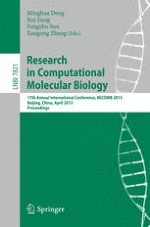This book constitutes the refereed proceedings of the 17th Annual International Conference on Research in Computational Molecular Biology, RECOMB 2013, held in Beijing, China, in April 2013. The 32 revised full papers were carefully reviewed and selected from 167 submissions. The papers cover a wide range of topics including molecular sequence analysis; genes and regulatory elements; molecular evolution; gene expression; biological networks; sequencing and genotyping technologies; genomics; epigenomics; metagenomics; population, statistical genetics; systems biology; computational proteomics; computational structural biology; imaging; large-scale data management.
